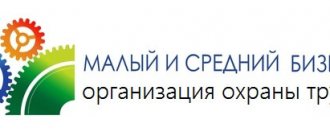The safety of workers is one of the most important tasks of the employer. To do this, the organization must take all measures to prevent accidents from occurring. The employer’s responsibility is to organize work in the field of labor protection and train personnel in safety standards. For this purpose, not only regulatory documents are being developed, but also a labor protection service is being created.
The work of the commission is aimed at coordinating the actions of the workforce in order to comply with labor protection legislation, preventive measures for injuries at work, as well as checking working conditions for compliance with their safety standards. The commission also participates in the development and adjustment of the collective agreement regarding labor protection.
The commission (committee) on labor protection is an elected body, where representatives of the company administration and its employees participate. The commission should cover all aspects regarding compliance with occupational safety standards in the organization. It is not a mandatory body in the structure of the company; it is elected on a voluntary basis.
It should be taken into account that the occupational safety commission differs in terms of powers and scope of activity from the knowledge testing commission. These concepts should not be confused.
Who is on the commission?
The creation of a labor protection commission is regulated by labor legislation. Article 218 of the Labor Code states that the initiator can be:
- the employer himself;
- employees of the organization;
- representatives of a trade union or other representative body of the team.
Therefore, it must include representatives of the organization’s workforce, its management team and the trade union committee. Its number depends on the number of employees in the organization, as well as the structural units of the company and its other features.
As a rule, the head of the organization is elected as the chairman of the commission, and an employee of the labor protection service is appointed as the secretary. All its members must undergo appropriate training at least once every 3 years. They perform their duties during working hours and are paid in the usual manner.
Mandatory or not?
The main provisions on the formation of occupational safety committees are set out in Article 218 of the Labor Code of the Russian Federation. But its creation is not a mandatory condition for the employer.
For example, the absence of an occupational safety committee at Gazpromneft-Chelyabinsk LLC was not recognized as a violation of the law in court.
Let us briefly outline the essence of the matter.
When the labor inspectorate checked compliance with labor safety rules at Gazpromneft-Chelyabinsk LLC, several violations were identified. One of them was that the manager of the enterprise did not form an occupational safety committee.
The administration of the organization received an order to eliminate violations and the need to organize a commission on occupational safety. However, the company's management did not agree with the labor inspector's demands and a lawsuit was filed.
In the court of first instance, many of the points of the order were declared illegal, but the obligation to create a committee was recognized as a justified violation of Art. 218 Labor Code of Russia.
Since the employer was not satisfied with the decision of the court of first instance, the case was considered based on his complaint in the court of appeal. He justified his disagreement by the fact that Article 218 of the Labor Code of the Russian Federation does not require the creation of a committee on occupational safety.
In the course of considering this issue, the appeal court came to the conclusion that the right to create a trade union (Article 21 of the Labor Code of the Russian Federation) and to nominate members to exercise powers on labor protection (Article 370 of the Labor Code of the Russian Federation) is reserved to employees. Therefore, the employer cannot be required to create a commission by occupational safety inspectors.
The law states that the right to take initiative is reserved for employees, their representative body or employer. But this is not their responsibility, so management may or may not show it.
In addition, when studying the materials in this case, the court did not find evidence that the working personnel of the enterprise came up with a proposal to create a committee on occupational safety, but it was not formed due to the fault of the management administration.
Taking these circumstances into account, the appeal court came to the conclusion that the order of the labor inspectorate and the decision of the trial court were illegal.
On this basis they were cancelled.
Powers of the committee
The commission is authorized:
- organize joint events between the team and the employer aimed at ensuring labor safety requirements, preventing occupational diseases and injuries at work;
- initiate and conduct inspections to ensure compliance with labor safety standards in the workplace;
- inform the workforce about the results of inspections;
- collect proposals in the field of labor protection to reflect them in the collective agreement.
All these powers of the commission must be enshrined in the regulatory act of the organization - the Regulations. Its standard version was approved by Order of the Ministry of Labor dated June 24, 2014 No. 412n. The employer has the right to use it as a basis and make changes depending on the specifics of the organization’s activities.
Regulations on the Labor Safety Commission
A commission is formed in accordance with the regulations adopted at the enterprise. This document is the main one in regulating the work of this body. The regulations are drawn up through the submission of proposals and the participation of all parties. It is put into effect by the approval of the company management.
How to prepare and approve the position?
The preparation of the regulations takes place during a general meeting of the company’s employees with the involvement of the work collective itself, the administration of the organization and, if available, representatives of the trade union cell in the discussion. Based on the agreement, the document is drawn up and approved.
The regulations on the creation of the commission must stipulate:
- composition of the commission;
- the number of its members;
- the period for assigning the relevant powers.
Responsibilities of the commission
The duties and functions of the qualification commission are approved in the relevant local Regulations. She conducts an initial test of theoretical knowledge, which is prescribed by the ETKS in the sections “Characteristics of work” and “Must know” of the category for which the employee is applying.
Source:
Personnel portal CLUB TK
Heading:
Personnel management (outsourcing, outstaffing)
advanced training training of specialists qualification exam
- Liskova Svetlana
Sign up 6825
9750 ₽
–30%
Standard provision No. 412n
The standard document regulating the work of the occupational safety commission contains all the basic rules that define:
- general provisions;
- tasks;
- functions;
- rights.
Let's look at these sections in more detail.
General provisions
The section briefly outlines the regulatory basis for the creation of the commission and the purpose of its creation. Clarifies that it is an integral part of the occupational safety management system, and also works in close cooperation with the management of the organization, its staff, as well as the supervisory authorities of the constituent entities of the Russian Federation in the field of labor protection.
In its activities, the committee relies on the regulatory framework of the current legislation.
Tasks
The regulations should cover as fully as possible the tasks assigned to the commission. The standard provision contains the following:
- development of a program of joint activities of all structures of the organization and competent authorities aimed at complying with standards in the field of labor protection, as well as constantly working to prevent injuries and occupational diseases;
- regularly check the condition of production premises and places of work of workers, analyze the data obtained and make proposals to the employer aimed at improving working conditions;
- interact with the team, inform them about what risks they may be exposed to during the production process, what protection and compensation they are entitled to.
Functions
The standard provision recommends assigning the following functional responsibilities to the committee:
- constantly work on the issue of improving occupational safety in close cooperation with the manager, the team and the trade union, promote the training of workers and conduct briefings aimed at improving their knowledge in the field of labor protection;
- take an active part in workplace inspections, recommend the employer to introduce new, safer methods;
- inform the team about the activities carried out, the results of inspections, the results of workplace certification, standards for the provision of personal and collective protective equipment, and methods of their use;
- interaction with the occupational safety service regarding periodic medical examinations of workers, medical. examinations upon hiring, provision of dairy products to persons working in hazardous industries, consideration of financial issues for the implementation of measures aimed at occupational safety, introduction of modern production technologies;
- invite the employer to improve mechanisms in the field of labor protection by sending him relevant submissions;
- participate in the development of local acts of the organization in the field of occupational safety.
Rights
The assigned functions can only be performed if you have the appropriate rights, therefore the commission has the right to:
- be informed about working conditions, the presence of injuries at work and the incidence of occupational diseases, as well as the presence of dangerous and harmful factors and the risk for workers working under their influence;
- participate in committee meetings, where representatives of the employer and its structural divisions report on what measures are being taken for labor protection in the workplace, violations committed that entailed serious consequences, and propose penalties to the employer in accordance with current laws;
- make proposals for improving the collective agreement regarding occupational safety;
- invite employers to encourage activists who make innovative proposals to improve working conditions;
- take part in resolving labor disputes regarding labor safety.
OT Knowledge Testing Commission
Reasons for testing knowledge of labor protection requirements:
- The employer is obliged to ensure that a knowledge test is carried out - Article 212 of the Labor Code of the Russian Federation;
- The employee is required to undergo a knowledge test - Article 214 of the Labor Code of the Russian Federation.
This article addresses the following issues:
- how knowledge of labor protection requirements is tested;
- who conducts the knowledge test;
- frequency;
- what documents are drawn up.
The procedure for training in labor protection and testing knowledge of labor protection requirements for employees of organizations is approved by Resolution of the Ministry of Labor and Social Development and the Ministry of Education of the Russian Federation dated January 13, 2003 No. 1/29.
In accordance with the Training Procedure, all employees of organizations, within a month after being hired, as well as during their work activities at certain intervals, must undergo occupational safety training and testing of knowledge of occupational safety requirements.
Managers and specialists undergo knowledge testing at least once every 3 years (clause 3.2 of Resolution of the Ministry of Labor and Ministry of Education No. 1/29). The frequency of testing workers' knowledge is normatively fixed for each specific type of work. Clause 2.2.3. Resolution of the Ministry of Labor and the Ministry of Education No. 1/29 states that the employer himself establishes the procedure and frequency of testing knowledge of labor protection requirements for blue-collar workers, guided by the requirements of the state Labor Safety Rules governing the safety of specific types of work. It is recommended to test workers’ knowledge of labor safety requirements annually. Thus, it will be possible to maintain the required level of knowledge of workers and provide additional measures to reduce occupational injuries and the level of occupational risk in the workplace.
The first persons of the companies, the head of the organization, his deputies in charge of labor protection issues, technical director, chief engineer, labor protection specialists, persons responsible for the state of labor protection in the areas (divisions) entrusted to them, persons conducting labor safety briefings, – All of them are tested on their knowledge of labor protection requirements at the educational center where they were trained.
In educational centers, the commissions for testing knowledge of labor protection requirements include managers and teachers of these organizations.
Managers and specialists of organizations who are not responsible for organizing labor protection work, and blue-collar workers can undergo training and knowledge testing within the organization. To test knowledge of labor protection requirements, organizations can create their own commissions to test knowledge of labor protection requirements. The main task of the knowledge testing commission is to check whether the level of knowledge of the organization’s employees in the field of labor protection is sufficient for them to safely perform their work functions in accordance with state requirements in the field of labor protection.
The knowledge testing commission is created by order of the head of the organization - order form.
The commission for testing knowledge of labor protection requirements for employees of an organization must consist of at least three people.
The training of members of the knowledge testing commission is subject to special requirements in the field of labor protection. Members of the commission for testing occupational safety knowledge must also undergo training and testing of knowledge of labor protection requirements at a licensed training center. An educational center must be included in the state register of accredited organizations providing services in the field of labor protection and have a license to conduct educational activities. Currently, members of knowledge testing commissions at the Occupational Safety and Health Education Center are trained and tested for knowledge of occupational safety requirements according to a 40-hour program.
Only employees who have undergone training and testing of knowledge of labor protection requirements at the educational center can be included in the commission. (including those who have completed distance learning) For the work of the commission to test knowledge of labor protection requirements, a commission chairman, deputy (deputy) chairman, secretary and members of the commission are appointed. The chairman of the commission may be the head of the organization or his deputy, who oversees issues in the field of labor protection; for example, for separate divisions, the chairman of the commission may be the head of the division. The deputy chairman performs the functions of the chairman of the commission during his absence, therefore, first assistants, chief and leading specialists are appointed as deputy chairmen of the commission, there may be several of them (it all depends on the number of employees and the specifics of the organization’s work). The secretary may be a labor protection specialist. The responsibilities of the secretary include maintaining, registering and storing documents drawn up during the knowledge test. If the organization does not have a labor protection specialist (if the number of employees is less than 50 people), the functions of the commission secretary, by decision of the chairman, can be assigned to any member of the commission.
In case of absence, vacation or illness of one of the commission members, in order not to paralyze the work of the knowledge testing commission, it is recommended to train and create a commission of five to six people. This point is relevant for small organizations. To ensure a reduction in industrial injuries and maintain healthy and safe working conditions in the organization, the work of the knowledge testing commission must be permanent (continuous) in nature. In its work, the commission, when checking the knowledge of labor protection requirements of managers and specialists, evaluates the employee’s knowledge of regulatory legal acts on labor protection, ensuring and complying with the requirements of which is his responsibility, taking into account job responsibilities and the nature of production activities. Testing the knowledge of blue-collar workers is carried out to the extent of knowledge of the requirements of labor protection rules and instructions.
The form of testing knowledge of labor protection requirements may be different. Depending on the order established in the organization. For example, oral, written or using personal computers and special programs. If the decision of the commission establishes that the employee showed a satisfactory result during the test and has a sufficient knowledge in the field of labor protection, then such employee is considered to have passed the knowledge test. If the commission has doubts about the sufficiency of the employee’s training and level of knowledge, and such employee showed unsatisfactory results during the knowledge test, then such employee is considered to have failed the knowledge test.
Based on the results of the knowledge test, a protocol is drawn up. The protocol contains basic information about the commission and the person being inspected. The results of the knowledge test (pass/fail) are reflected in the protocol. The protocol is signed by the person being checked, the chairman and members of the commission - the form of the protocol.
The commission for testing knowledge of labor protection requirements, in accordance with Article 76 of the Labor Code of the Russian Federation, must submit a petition to the head of the organization to remove from work (not allow to work) an employee who has not passed the test of knowledge of labor protection requirements. The employee is suspended for the entire period of time until he successfully passes the knowledge test. A repeated knowledge test must be completed no later than one month from the date of failure to pass the exam. No wages will be accrued during the period of suspension. Employees who successfully pass the test of knowledge of labor protection requirements are issued a certificate signed by the chairman of the commission, certified by the seal of the organization.
You should be aware of the existence of a non-mandatory document - GOST 12.0.004-2015 System of Occupational Safety Standards (OSSS). Organization of occupational safety training. General provisions.
Sample order for the creation of a labor safety commission
After the regulation on the occupational safety commission has been adopted, an order on its creation must be issued. This act must be previously agreed upon with the trade union body of the enterprise.
Also, the order to create a labor safety commission appoints representatives of the administration who will take part in its work. Representatives of workers and the primary trade union organization, in turn, are approved at the general meeting and are also listed in the order. The order itself is an ordinary administrative document, and its preparation should not cause any difficulties.
Order form for the creation of a labor safety commission in 2020
When an organization is created, how many people are needed?
A commission of this type can be created in any organization, regardless of the direction of its professional activity.
The creation of a commission is not a mandatory event, control over the implementation of which rests with the employer. The current legislation of the Russian Federation allows the absence of this committee.
The formation of the commission is carried out on the basis of the information reflected in Article 218 of the Labor Code of the Russian Federation. According to established standards, the creation of a committee should be carried out by specialists appointed by the employer as responsible persons.
In general, the creation process must comply with the provisions of the Regulations on the Labor Protection Commission.
Work plan of the labor protection commission in the organization
After approval of the composition of the commission and consolidation of its powers, a work plan is developed. It should indicate not only measures in the field of labor protection, but also the deadlines for their implementation. The plan is approved at a meeting of the commission and signed by the chairman and secretary.
Sample:
Read more - Action plan to improve occupational safety conditions at the enterprise in 2021
Meetings of the commission are subject to mandatory minutes. You can download an example of a protocol form for the occupational safety commission below. ↓
Minutes of the meeting of the labor safety commission - sample form
Goals, objectives and functions
The main goal of creating an association of representatives of the parties is to ensure the proportional participation of all workers in solving various issues in order to comply with safe conditions, hygiene rules and the working environment while employees perform their job duties.
Priority tasks of the MPC:
- compliance with TB regulations;
- monitoring compliance with occupational safety requirements;
- inspection and certification of workplaces;
- participation in the acceptance of buildings, structures and other objects into operation;
- conducting emergency incident investigations;
- studying the causes that led to the occurrence of occupational diseases;
- others that are aimed at protecting the health of workers.
In order for the labor protection commission to fulfill all its assigned tasks, it is assigned certain functions.
The priority actions of the commission are:
- Representatives must study and consider at meetings proposals on occupational safety received from the employer, trade union committee or workers.
- Recommend to employers measures that are aimed at ensuring the safety of the life and health of employees during work.
- Participate in surveys of working conditions in the premises and throughout the organization.
- Focus the attention of responsible persons on identified violations in the field of occupational safety in order to eliminate them.
- Consider requests from employees complaining about poor compliance with safety regulations by enterprise managers.
- Analyze the causes that led to injuries and develop an action plan to prevent their recurrence.
- Study the factors that caused occupational diseases in workers in order to eliminate or reduce their impact.
- Check the effectiveness of TB measures.
- Prepare messages and data about the actual state of the OT service in the enterprise.
- Participate in workplace certification.
- Assist in updating technological equipment using the latest technologies to improve OSH practices.
- Coordinate items in the enterprise budget related to improving working conditions.
- Monitor the provision of the organization’s staff with all necessary personal protective equipment and protective clothing.
- Assist the administration of the organization in training personnel in order to use safe methods and techniques in work.
- Insist on timely training to familiarize workers with safety regulations.








